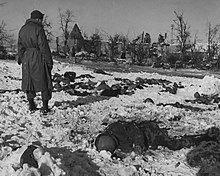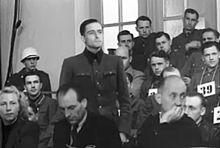Malmedy massacre
Prelude
Kesternich - Wahlerscheid
German attack
Losheimergraben - Clervaux - Stößer - Greif
Allied defense and counter-attack
Elsenborn ridge - St. Vith - Bastogne - Bure
German counterattack
base plate - north wind
The Malmedy massacre was a war crime committed on December 17, 1944 in the course of the Battle of the Bulge in World War II . At least 82 US prisoners of war were shot by members of the Waffen SS . The place of the event was at Malmedy .
prehistory
The Ardennes Offensive was the last attempt by the Wehrmacht to regain the initiative on the Western Front . In the winter of 1944, three German armies of Army Group B were supposed to repel the Allied troops 'advance in the direction of the Rhine in the rough terrain of the Ardennes and to interrupt the Allies' main supply lines with a surprise advance to Antwerp . The German commanders wanted to split the anti-Hitler coalition with the "Operation Herbstnebel" and bring about an end to the fighting in the West.
During a briefing at the Adlerhorst command post near Bad Nauheim on December 12, 1944 , Adolf Hitler described the imminent winter offensive in front of his assembled generals as “the most important battle in a decisive war of life and death”. According to those involved at the time, Hitler also gave orders that prisoners should only be taken if the “tactical situation” permitted. Correspondingly, instructions on “ruthless hardship” were passed on from the higher-level command posts to the subordinate units, including Josef Dietrich . According to the indictment in the later trial, he is said to have given instructions to ignore the provisions of international war law.
The Peiper Combat Group
The battle group Peiper under the command of SS Standartenfiihrer Joachim Peiper was an approximately 1,000 men and 100 armored vehicles comprehensive Association of the 1st SS Panzer Division "Leibstandarte SS Adolf Hitler" . For the Battle of the Bulge, the combat group of the 6th Panzer Army under Josef Dietrich was assigned, and they were to provide the head of the attack. The task of Peiper's association was the rapid advance to the Meuse bridges at Huy and the opening of a corridor for troops to follow. Like Peiper himself, most of his subordinates had fought on the Eastern Front before . Before the start of the offensive, Peiper's troops were way behind schedule and threatened to jeopardize the entire operation. Since the Leibstandarte SS “Adolf Hitler” saw themselves as an elite , fear of failure put the commanders of the combat group under great pressure.
The massacre
On December 17, 1944, the second day of the Ardennes Offensive, the fast-moving Peipers armored force encountered a truck convoy from Battery B of the 285th Field Artillery Observation Battalion of the United States about four kilometers southeast of Malmedy - at the Baugnez intersection Army . Immediately after its discovery, the convoy was shot at and overwhelmed. The leading attackers of Kampfgruppe Peiper - including Joachim Peiper himself - did not care about the - now captured - Americans and drove on. Members of the subsequent SS units placed the slightly more than 100 prisoners on a meadow near the intersection. The exact sequence of the following massacre or a possible existing chain of command for the subsequent events has not yet been clarified. Possibly the unguarded captured American soldiers tried to flee together to a forest about 60 m away.
What is certain, however, is that around noon on December 17, the SS men opened fire several times in succession with submachine guns and their vehicles' weapons on several groups of captured Americans - including the wounded. Then individual SS men killed the survivors by shooting at close range, which later proved that it had been a crime and not a normal battle . In total, at least 82 Americans died. They were only found by their comrades in January 1945.
The consequences of the massacre
54 GIs (including the American actor Charles Durning ) survived without being noticed by the SS troops and fled after the German troops withdrew. By the afternoon of December 17th, the first men had made their way to their own lines. On December 18, the Allied High Command was informed of the incident. Although it was not and did not remain the SS's only war crime against the Western powers, Malmedy later assumed a symbolic position: the massacre stood for the brutal ruthlessness with which the war was waged on the German side.
The massacre did not remain hidden from the public for long. The first reports were already circulating in the Allied press on December 21. Another report appeared in TIME magazine on December 25th, and further articles followed in the army newspaper The Stars and Stripes and in Newsweek . On December 30, 1944, the US State Department asked the Swiss embassy to hand over a protest note requesting an investigation into the incident to the German government . Citing the results of the investigation by the Wehrmacht investigation agency set up for such cases , the Foreign Office denied the incident in a note sent on March 8th.
After the Malmedy massacre, the 328th Infantry Regiment of the 26th Infantry Division issued an order not to take any prisoners from members of the Waffen SS or paratroopers . Some US units are said to have routinely killed SS prisoners. According to Peter Schrijvers, the 90th Infantry Division on the Saar killed their prisoners from the Waffen SS in December 1944 in such a systematic way that the leadership issued express orders to let prisoners of the Waffen SS live in order to obtain information from to be able to receive them. In the Chenogne massacre on New Year's Day 1945, US soldiers shot several dozen German prisoners of war from the Wehrmacht . According to an assessment by Peter Lieb , General George Patton refers to this massacre in his diary with his entry: “The 11th Armored is very green and took some unnecessary losses to no effect. There were also some unfortunate incidents in the shooting of prisoners. I hope we can conceal this. ”Lieb thinks it likely that in the weeks leading up to the end of the war, US troops often shot German prisoners, especially those from the Waffen-SS.
Legal processing
After the end of the war, the Malmedy Trial took place in Dachau in May 1946 , during which the SS men involved, who could still be tracked down by the Allies, were brought to justice. There were 43 death sentences and 22 life sentences . However, there were also doubts about the legality of the whole procedure, since the investigating authorities did not always proceed according to the rule of law. Eventually, a US Senate subcommittee investigated the matter. The US Army had since overturned some death sentences. The other judgments were also softened in the period that followed, and the appeals for clemency from the remaining SS men who had been sentenced to death were granted by the commander-in-chief of the US armed forces in Germany, General Thomas T. Handy . In April 1948, the first convicts from War Criminals Prison No. 1 released in Landsberg am Lech . At the end of 1953 32 and at the end of 1954 there were still ten convicts in prison. Most recently, Georg Preuss (November 30, 1956), Peiper (December 22, 1956) and the Austrian Hubert Huber (January 29, 1957) were released. Not a single death sentence was ultimately carried out.
Today a memorial and a museum at the scene of the event in Malmedy-Baugnez commemorate the US soldiers murdered by the soldiers of the Waffen-SS.
Movies
- The last battle , 1965
- Saints and Soldiers , 2003
- No grass grows over the gallows. (Documentation)
literature
- John M. Bausermann: The Malmédy Massacre. Shippensburg 1995.
- Peter M. Quadflieg , René Rohrkamp (Ed.): The "Malmedy Massacre". Perpetrators, victims, research perspectives. A work book. Shaker, Aachen 2010, ISBN 978-3-8322-9241-6 .
- Danny Parker, Fatal Crossroads: The Untold Story of the Malmédy massacre at the Battle of the Bulge. Cambridge, Mass., Da Capo Press 2011, ISBN 978-0-306-81193-7 .
- Steven P. Remy: The Malmedy Massacre: The War Crimes Trial Controversy. Harvard University Press , 2017, ISBN 978-0-674-97195-0 .
Web links
- Michael Reynolds: Massacre At Malmédy During the Battle of the Bulge at www.historynet.com
- Documentary compilation in the Steven Spielberg Film and Video Archive of the United States Holocaust Memorial Museum
supporting documents
- ^ A b John M. Bausermann: The Malmédy Massacre. Shippensburg 1995, p.
- ↑ Manfred Thorn: From the Leibstandarte to the scapegoat and whipping boy. Riesa 2016, ISBN 978-3-944580-12-8 , pp. 93 f.
- ↑ Hugh M. Cole: Chapter XI. The 1st SS Panzer Division's Dash Westward, and Operation Greif . In: The Ardennes: Battle of the Bulge . Office of the Chief of Military History , Department of the Army, Washington, DC, United States 1965, pp. 261-264 (Retrieved June 3, 2006).
- ↑ Peter Schrijvers: The Crash of Ruin: American Combat Soldiers in Europe During World War II , pp. 79-80.
- ↑ Peter Lieb: Conventional War or Nazi Weltanschauungskrieg ?: Warfare and Fight against Partisans in France 1943/44 . Walter de Gruyter, Berlin 2007, p. 175.
- ↑ George Patton: Martin Blumenson (Ed.): The Patton Papers 1940-1945 1996, p. 615.
- ↑ Investigation of action of army with respect to trial of persons responsible for the massacre of American soldiers, Battle of the Bulge, near Malmedy, Belgium, December 1944. (PDF; 2.09 MB) In: Malmedy Massacre Investigation, Report of Subcommittee of the Committee on Armed Services. U.S. Senate, October 13, 1949, accessed December 18, 2019 .
- ^ Jens Westemeier: Himmler's warriors. Joachim Peiper and the Waffen-SS in the war and the post-war period. (= War in History. Volume 71) Schöningh, Paderborn 2014, ISBN 978-3-506-77241-1 , p. 856 f.
- ^ Brooklyn College | Graduate Center
Coordinates: 50 ° 24 ′ 14 ″ N , 6 ° 3 ′ 58 ″ E



